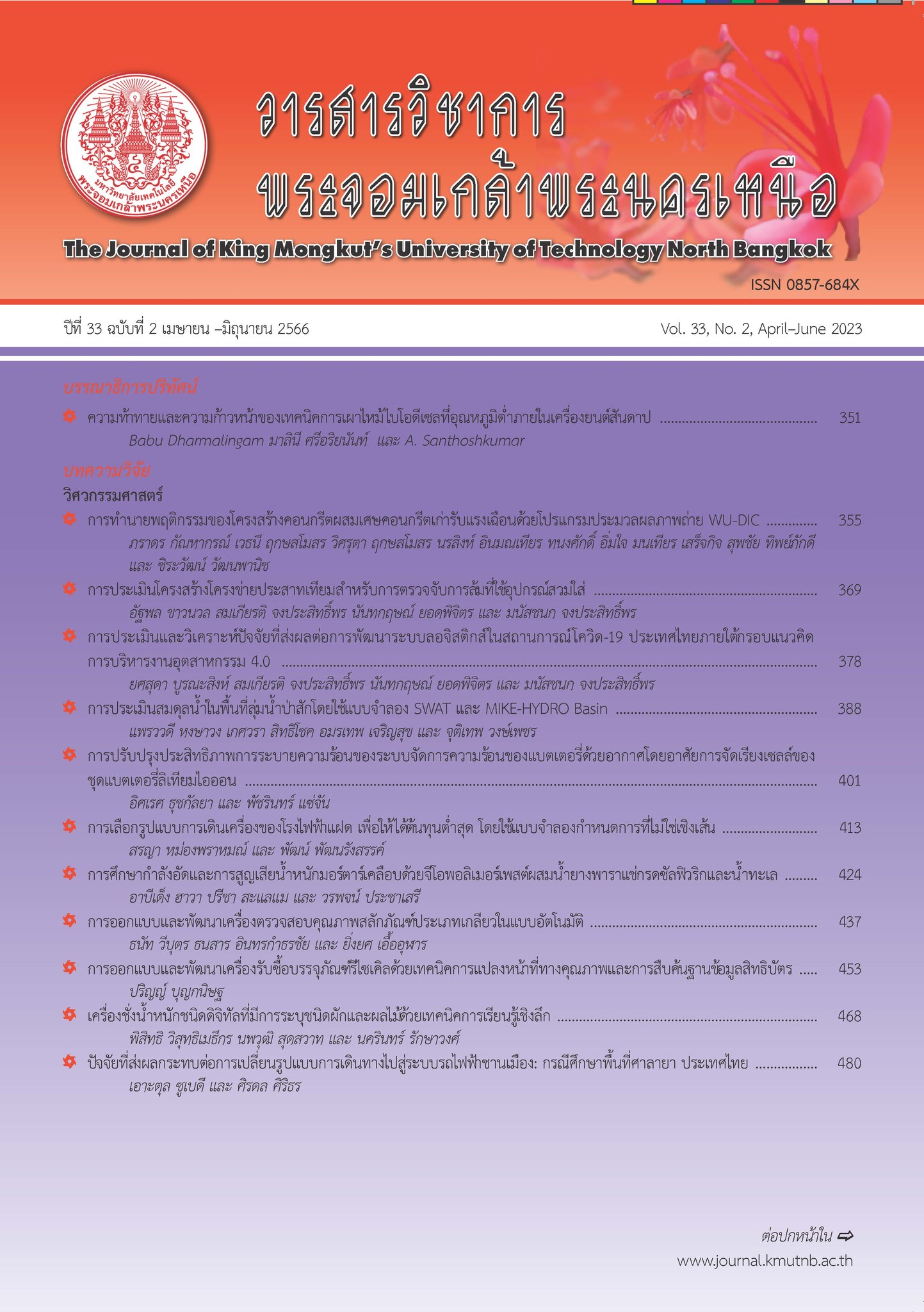สมูทไฟไนท์เอลิเมนต์รูปหลายเหลี่ยมที่ใช้โดเมนสม่ำเสมอแบบเอลิเมนต์ทรงสี่หน้าสำหรับปัญหาความเค้นในระนาบสองมิติ
Main Article Content
บทคัดย่อ
งานครั้งนี้ ทำการศึกษาวิธีสมูทไฟไนท์เอลิเมนต์แบบแบ่งเอลิเมนต์หลักเป็นรูปหลายเหลี่ยมซึ่งมีการแบ่งโดเมนย่อยสม่ำเสมอภายในเอลิเมนต์หลักนั้นออกเป็นเอลิเมนต์ทรงสี่หน้า โดเมนขอบเขตของปัญหาซึ่งถูกแบ่งออกเป็นรูปหลายเหลี่ยมนั้น ถูกสร้างขึ้นมาจากการแปลงของเอลิเมนต์สามเหลี่ยมหรือสี่เหลี่ยมจากขั้นตอนการสร้างโครงตาข่ายของวิธีไฟไนท์เอลิเมนต์ สำหรับโดเมนสม่ำเสมอนั้น เอลิเมนต์ทรงสี่หน้าถูกสร้างขึ้นเท่ากับจำนวนด้านของเอลิเมนต์รูปหลายเหลี่ยม ความเค้นในระนาบสองมิติของคานยื่นปลายรับแรงเฉือนพาราโบล่าที่ปลายคานอิสระถูกใช้เป็นปัญหามาตรฐานสำหรับการตรวจสอบความสามารถของวิธีนี้ ผลตอบสนองของคานได้แก่ค่าการเปลี่ยนตำแหน่งและความเค้นซึ่งได้จากการวิเคราะห์เชิงตัวเลขจะถูกนำไปเปรียบเทียบกับผลจากการวิเคราะห์ด้วยไฟไนท์เอลิเมนต์และทางทฤษฎี ถึงแม้ว่าผลจากการวิเคราะห์เชิงตัวเลขที่ได้มีค่าอยู่ระหว่างผลจากการวิเคราะห์ด้วยวิธีไฟไนท์เอลิเมนต์แบบ T3 และ Q4 ในช่วงของโครงตาข่ายที่มีความละเอียดต่ำ ความแม่นยำในการคำนวณและเข้าใกล้ค่าทางทฤษฎีที่มากกว่าวิธีไฟไนท์เอลิเมนต์นั้น ได้จากการใช้ความละเอียดสุดของโครงตาข่ายเป็น 48X12 ในมุมมองของผู้เขียนเชื่อว่า การไม่ต้องทำ mapping ระหว่าง physical and parent elements และความยืดหยุ่นของการใช้รูปหลายเหลี่ยมสมูทไฟไนท์เอลิเมนต์นี้ สามารถนำไปประยุกต์ใช้กับรูปร่างหรือขอบเขตที่มีความซับซ้อนหรือในบริเวณที่มีความไม่เข้ากันของโครงตาข่ายได้อย่างมีประสิทธิภาพ
Article Details

อนุญาตภายใต้เงื่อนไข Creative Commons Attribution-NonCommercial-NoDerivatives 4.0 International License.
บทความที่ลงตีพิมพ์เป็นข้อคิดเห็นของผู้เขียนเท่านั้น
ผู้เขียนจะต้องเป็นผู้รับผิดชอบต่อผลทางกฎหมายใดๆ ที่อาจเกิดขึ้นจากบทความนั้น
เอกสารอ้างอิง
G. Liu, K. Dai, and T. Nguyen, “A smoothed finite element method for mechanics problems” Computational Mechanics, vol. 39, no. 6, pp. 859–877, 2007.
W. Junchum, K. Musiket, B. Puangpaingam, and S. Pongsivasatit, “Two-dimenstional plane stress analysis by smoothed finite element method using 4 smoothing cells created by an arbitrary quadrilateral element,” Engineering Journal of Research and Development, vol. 32, no. 3, 2021 (in Thai).
G. R. Liu and N. Trung, Smoothed Finite Element Methods, Boca Raton, FL: CRC Press, 2010, ch. 4, sec. 4.1-4., pp. 84–132.
A. Hamrani, S. H. Habib, and I. Belaidi, “CS-IGA: A new cell based smoothed isogeometric analysis for 2D computational mechanics problems,” Computer Methods in Applied Mechanics and Engineering, vol. 315, pp. 671–690, 2017.
D. Wang, H. Zhang, and J. Xuan, “A strain smoothing formulation for NURBS-based isogeometric finite element analysis,” Science China Physics, Mechanics and Astronomy, vol. 55, no. 1, pp. 132–140, 2012.
K. Dai and G. R. Liu, “Free and forced vibration analysis using the smoothed finite element method (SCFEM),” Journal of Sound and Vibration, vol. 301, no. 3-5, pp. 803–820, 2007.
S. P. Bordas, T. Rabczuk, N. X. Hung, V. P. Nguyen, S. Natarajan, T. Bog, and N. V. Hiep, “Strain smoothing in FEM and XFEM,” Computers & Structures, vol. 88, no. 23–24, pp. 1419–1443, 2010.
H. Nguyen-Xuan and T. Nguyen-Thoi, “A stabilized smoothed finite element method for free vibration analysis of Mindlin–Reissner plates,” Communications in Numerical Methods in Engineering, vol. 25, no. 8, pp. 882–906, 2009.
F. Aldakheel, B. Hudobivnik, A. Hussein, and P. Wriggers, “Phase-field modeling of brittle fracture using an efficient virtual element scheme,” Computer Methods in Applied Mechanics and Engineering, vol. 341, pp. 443– 466, 2018.
A. Hussein, F. Aldakheel, B. Hudobivnik, P. Wriggers, P. A. Guidault, and O. Allix, “A computational framework for brittle crackpropagation based on efficient virtual element method,” Finite Elements in Analysis and Design, vol. 159, pp. 15–32, 2019.
C. Song and J. P. Wolf, “The scaled boundary finite-element method alias consistent infinitesimal finite-element cell method for elastodynamics,” Computer Methods in Applied Mechanics and Engineering, vol. 147, no. 3–4, pp. 329–355, 1997.
H. Guo, E. T. Ooi, A. A. Saputra, Z. Yang, S. Natarajan, E. H. Ooi, and C. Song, “A quadtreepolygon- based scaled boundary finite element method for image-based mesoscale fracture modelling in concrete,” Engineering Fracture Mechanics, vol. 211, no. 15, pp. 420–441, 2019.
K. Y. Dai, G. R. Liu, and T. T. Nguyen, “An n-sided polygonal smoothed finite element method (nSFEM) for solid mechanics,” Finite Elements in Analysis and Design, vol. 43, no. 11–12, pp. 847–860, 2007.
E. T. Ooi, C. Song, F. Tin-Loi, and Z. J. Yang, “Automatic modelling of cohesive crack propagation in concrete using polygon scaled boundary finite elements,” Engineering Fracture Mechanics, vol. 93, pp. 13–33, 2012.
S. P. Timoshenko and J. M. Gere, Theory of Elasticity, 3rd ed. McGraw-Hill, 1970.

